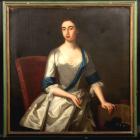Lady Frances Coningsby was born on 15 January 1707/8 at Hampton Court, Herefordshire, England. She was the daughter of Thomas Coningsby, 1st Earl of Coningsby and Lady Frances Jones.She was baptised on 13 February 1707/8 at St. Martins in the Fields, London, England. She married Sir Charles Hanbury-Williams, son of John Hanbury and Bridget Ayscough, in July 1732.7 She died before 31 December 1781. She was buried on 31 December 1781 at Westminster Abbey, Westminster, London, England. She was also known as Lady Frances Coningsby. Her married name became Hanbury. In 1719 younger daughter and coheir of 1st Earl of Coningsby of the cr.7 From July 1732, her married name became Hanbury-Williams. Her husband Sir Charles was the son of John Hanbury, a Welsh ironmaster, assumed the name of Williams under the terms of a bequest from his godfather Charles Williams, in 1720. On 1 July 1732 at Saint James, Westminster, London, he married Lady Frances Coningsby (15 January 1707/1708 - buried at Westminster Abbey, Westminster, London, 31 December 1781), daughter of Thomas Coningsby, 1st Earl Coningsby and Lady Frances Jones. They had two daughters: Frances married William Capel, 4th Earl of Essex and Charlotte Robert Boyle Walsingham, youngest son of the Earl of Shannon. He entered the British Parliament in 1734 representing the Monmouthshire constituency as a supporter of Robert Walpole, and held the seat until 1747. Sir Charles then won the seat of Leominster in 1754 which he held until his death. In 1739 he supported the establishment of the Foundling Hospital and served as one of its founding governors. From 1747 till 1750, he was the British ambassador in Dresden. In 1748 he was in Poland and witnessed a Polish Sejm, where he met members of the influential Czartoryski family (August Aleksander Czartoryski). When the future King of Poland, Stanislaw Poniatowski, was receiving medical treatment in Berlin, he met with Sir Charles, who was sent there as ambassador (1750–1751). The Englishman became part of Polish and Russian history by introducing Stanislaw to the Russian Grand Duchess Catherine Alexeyevna (Saint Petersburg 1755) (the future Catherine the Great, Empress of Russia). From this moment on began the famous romance between Catherine and the Polish aristocrat. His father bought the Coldbrook Park estate near Abergavenny for him from his godfather's bequest where in 1746 he reconstructed the house by adding a 9 bay 2 storey Georgian facade. He died insane in 1759 and the Coldbrook estate passed to his brother George. He played a major role as a British envoy during the Seven Years War at the court in Russia. While Russia was at war with Britain's ally Prussia, the two countries remained at peace. Sir Charles is recorded as a brilliant wit with a great reputation for lively and biting satire.He was the inspiration for the character Charles Edaston in the 1913 George Bernard Shaw play Great Catherine, which recounts the story of a British envoy to Catherine's court. It was made into a film starring Peter O'Toole in 1968. Williams also left poems which were said to be "witty but licentious"
Seeman [Zeeman], Enoch (1689/90–1744), portrait painter, was born at Danzig in Germany, where his father, of Flemish origin, Enoch Seeman (b. c.1661), was settled as a painter. It is possible that the famous German virtuoso painter Balthasar Denner, who received some of his early instruction in painting at Danzig, may have been a pupil of Seeman's father, for some of Seeman's early paintings were executed in imitation of Denner's highly detailed style, including a self-portrait at the age of nineteen.
In 1704 Seeman was taken by his father to London, and practised there as a portrait painter with great success. He resided in St Martin's Lane, and at first styled himself Enoch Seeman, junior. His earliest known portrait, Colonel Bissett and his Family (Forbes Castle, Aberdeenshire), inscribed ‘Enoch Seeman pinx. AE 18½ 1708’ (Allen, 352) was painted by more than one hand. He was probably helped in its execution by members of his family. Seeman's portraits or portrait groups were sometimes on a very large scale, such as the family group Lady Cust and Nine Children (1743) at Belton House, Grantham, his last recorded work. Seeman frequently painted his own portrait. An example of 1716 is in the British Museum, and was engraved by J. G. Schmidt. Another, with his daughter in boys' clothes, was at Strawberry Hill, Twickenham. A portrait by him of Sir Isaac Newton, formerly in the possession of Thomas Hollis FSA, was engraved in mezzotint by J. MacArdell. From 1717 Seeman received royal patronage, and painted a full-length portrait of George I (Middle Temple, London). He also painted George II and other members of the royal family. Another attributed work (c.1711–20) is a dual portrait of the first duke of Marlborough and the military engineer John Armstrong, now at Blenheim Palace, Oxfordshire.
Seeman died suddenly in St Martin's Lane, London, in March 1744. His son, Paul Seeman, painted portraits and still life, and his three brothers were all painters, one of whom, Isaac Seeman, died in London on 4 April 1751. The name is sometimes, but erroneously, spelt Zeeman. Further works by Seeman are in the National Portrait Gallery, London; Yale University Art Gallery, New Haven, Connecticut; the Metropolitan Museum of Art, New York; Dunham Massey, Cheshire; Belton House, Lincolnshire; and Dalkeith House, near Edinburgh.
L. H. Cust, rev. Sarah Herring DNB



